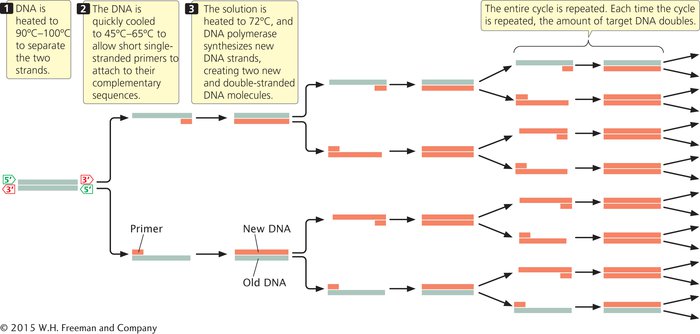Amplifying DNA Fragments by Using the Polymerase Chain Reaction
The manipulation and analysis of genes require multiple copies of the DNA sequences used. Because each gene is unique, it must be isolated and amplified before it can be studied. As we have seen, one way to amplify a DNA fragment is to clone it in bacterial cells. Indeed, for many years, gene cloning was the only way to amplify a DNA fragment, and cloning was a prerequisite for many other molecular methods. However, cloning is labor intensive, and at least several days are required to grow the bacteria. Today, the polymerase chain reaction makes the amplification of short DNA fragments possible without cloning, although cloning is still widely used for amplifying large DNA fragments and for other manipulations of DNA sequences.
The polymerase chain reaction (PCR), first developed in 1983 by Kary Mullis, allows DNA fragments to be amplified a billionfold within just a few hours. It can be used with extremely small amounts of original DNA, even a single molecule. The polymerase chain reaction revolutionized molecular biology and is now one of the most widely used molecular techniques. The basis of PCR is replication catalyzed by a DNA polymerase. Replication in this case has two essential requirements: (1) a DNA template from which a new DNA strand can be copied, and (2) a pair of primers with a 3′-OH group to which new nucleotides can be added.
Because a DNA molecule consists of two nucleotide strands, each of which can serve as a template for synthesis, the amount of DNA doubles with each replication event. The primers used in PCR to replicate the templates are short fragments of DNA, typically from 17 to 25 nucleotides long, that are complementary to known sequences on the template.
To carry out PCR, we begin with a solution that includes the target DNA, DNA polymerase, all four deoxyribonucleoside triphosphates (dNTPs—

381
The whole cycle is then repeated. With each cycle, the amount of target DNA doubles. One molecule of DNA increases to more than a thousand molecules in 10 PCR cycles, to more than a million molecules in 20 cycles, and to more than a billion molecules in 30 cycles. Each cycle is completed within a few minutes, so a large amplification of DNA can be achieved within a few hours. To see how PCR quickly increases the number of copies of a DNA fragment, view Animation 14.2.
A key innovation that facilitated the use of PCR in the laboratory was the discovery of a DNA polymerase that is stable at the high temperatures used in the first step of PCR. The DNA polymerase from E. coli that was originally used in PCR denatures at 90°C, so fresh enzyme had to be added to the reaction mixture in each cycle. This obstacle was overcome when DNA polymerase was isolated from the bacterium Thermus aquaticus, which lives in the boiling springs of Yellowstone National Park. This enzyme, dubbed Taq polymerase, is remarkably stable at high temperatures and is not denatured in the strand separation step of PCR; it can be added to the reaction mixture at the beginning of the PCR process and continues to function through many cycles.
CONCEPTS
The polymerase chain reaction is an enzymatic in vitro (in a test tube) method for rapidly amplifying DNA. In this process, DNA is heated to separate the two strands, short primers attach to the target DNA, and DNA polymerase synthesizes new DNA strands from the primers. Each cycle of PCR doubles the amount of DNA.